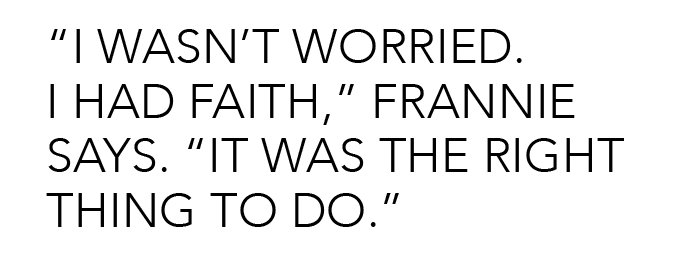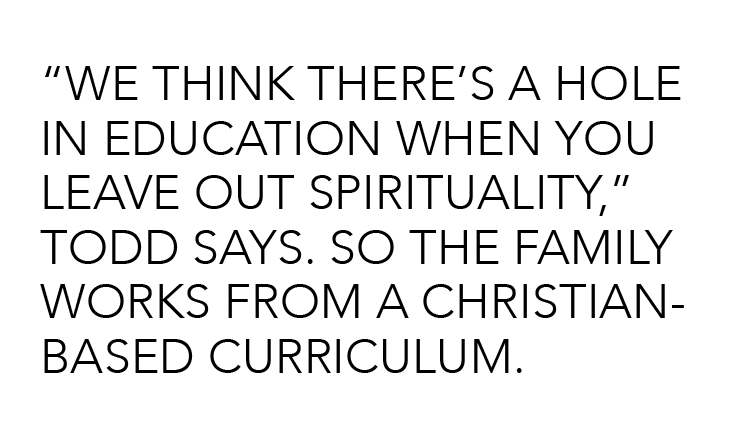Team Parenting 101
Can a “Real Man” stay at home? Can he successfully take over homeschooling the family’s kids and still keep his Dad-ness? Inspired by Clark Kent’s big secret, Todd White shows his true colors.
Chapter One:
Boy Meets Girl
In high school, Frannie Wagner was obsessed with Superman. Posters and pillows brightened her room, and she even wore a cape on Halloween, dressed as “SuperFran.” Her English essays featured her in the starring role, as Lois Lane. Teachers noticed her natural expression and self-possession, and encouraged her to make radio shows for English class. While still in high school, she got a job as the weekend weather anchor at KNBN, Rapid City’s NBC affiliate; by her senior year in college, she managed Black Hills State’s radio station. Lois Lane was on the rise.
Meanwhile, “city boy” Todd White had bolted from Delaware and into the Air Force with an undergraduate degree in communications. He arrived in Rapid City as a B-1 crew chief who knew something about television. He knew that Delaware falls into Philadelphia’s market, the fourth largest in the country—and that Rapid City was #175, smaller and easier to approach for a job. After his tour was over, Todd decided to stay in Rapid City. His first media job involved running a studio camera during newscasts—and then he transferred over to KNBN as a full-time news photographer. There, photographers “chauffered” reporters to the sites of stories they were covering together. By the time he got to KNBN, Frannie was a self-assured reporter. The question was whether he could become Clark Kent.
Just as in DC Comics, Frannie and Todd fell for each other, although Todd fell first. “Frannie was such a confident person,” Todd recalls. “I started to really like her, but I got the feeling that she couldn’t really care less. She’s not an easy sell.”
Eventually, however, she softened. “He treated me really, really well,” she says, “and I thought there was no possible way that anyone could treat me better than this guy does.” Everything was looking up for the couple, especially since Frannie was positioned to take over as the lead anchor for the station. “I thought I would work there forever,” she says.


Then boom! The romantic comedy—and the relationship—took a turn. Frannie remembers as if it were yesterday: “It was August 19, 2002, during the Battle Creek forest fire in the Black Hills,” she says. “I did the story—and then stayed for several extra hours because of the chaos of the fire.”
She finally drove to Todd’s house, exhausted. “We talked about this media career we thought we wanted,” she says. “I was working every weekend and holiday. And assuming I was promoted, then I would work every weekday until 10:30 at night.”
Todd’s schedule was no better; he worked late on every shift. “If we stayed, at least one of us would miss our future kids’ dinner hour,” he says. “We decided that our life together was more important than our individual careers.” This conversation would set the stage for how the couple would make important decisions throughout their marriage. They both decided to quit then and there.
The next morning found Todd and Frannie calculating their next move. “It was three months until we would be married, and in the meantime we had two house payments, and two cars,” she says.
Still, they looked ahead with hope. From midnight of August 20 onward, they simply knew they would be each other’s superhero.
Their first stop was the newspaper, where they started looking for work. Todd immediately found a post developing film for a local photo processor—a job still within his interest area of photography—while Frannie called on a listing for West River Business Service Center. There, she quickly found she could make more money as an administrative assistant than she had as Lois Lane. After two months, she transitioned to the SBA 504 loan program even though “I thought I was done with math after college algebra,” Frannie says. She went to Denver for a one-week training, popped home for her own wedding that Friday, and started doing 504 loans the next Monday.
That’s how superheroes do it.

Chapter 2:
Girl Has an Idea
Thirteen years and two children later, Frannie floated the question: Would Todd want to leave his day job and contribute to their family by homeschooling? “I thought, ‘I don’t like what I’m hearing,’” Todd says. “Because a man’s traditional role is to continue on a working path, like it or not, no matter what.” Surely, Clark Kent would never become a stay-at-home dad.
But Frannie had a point. Since leaving KNBN, Todd’s career path had been less direct than hers—after processing film, he had gravitated toward sales jobs, while she’d remained at the Business Service Center. His work wasn’t inspiring in the way he had envisioned a television career would be. And Frannie’s salary had grown enough that they could survive on her income.
A self-confessed “control freak and smother-mother,” she had already spent an entire summer researching homeschool curricula, and then taught her children for two years—while working full-time. Homeschool was just something she had always wanted to do. “I liked the idea because it provided more flexibility in a family’s life,” she says. “I wanted to be with my kids. I didn’t love the idea of sending them off for someone else to teach them.”
On the other hand, Todd had expressed reservations even at the early stages. “Frannie definitely had to convince me,” he says. “I had this idea of the ‘weird homeschooled kid’ with no social skills and no friends. I was way more hesitant than she was.” After seeing her research, Todd supported the experiment. “She had it all laid out,” he recalls. “She had to know what she was doing, to do both work and homeschool at same time.”
“I knew how much work each day would get us through the curricula in the year,” Frannie says. “On days when I was working at home, Asher sat at the table with me, doing his school work.”
Asher pipes up, “I remember her typing while checking my work at the same time, and I asked, ‘How are you doing this?’ It was crazy; it was awesome.”
By the time Frannie had the idea of transitioning out of the teacher role, she had laid the track for Todd. “But it had to be his decision. I just put a bug in his ear,” Frannie says. “The truth is that Todd is much more patient than I am, and he’s a better teacher. I knew he would be better at homeschooling than I was.”
The Whites were not anti-public school. Asher had attended Montessori preschool and kindergarten, and then public school through second grade. “At first, I thought it wouldn’t be fun, and that I would miss my friends,” he says. “But I got used to it quickly, mostly because I wasn’t understanding things in school. At home, though, we had a different curriculum—or maybe it was because of the different environment—but I said, ‘How was I not understanding this before?’”


Todd’s initial concerns about “weird homeschooled kids” disappeared once he saw his family in action. “In homeschool, the kids are well-rounded,” he says. “They spend time with people of all ages. They go to Sunday School, gymnastics, tae kwon do, piano, youth group at church,” he says. “They interact with kids in regular school and in the neighborhood; they all get along fine.”
With all of this evidence at hand, Todd considered what it would be like to be Dad and Teacher. “I realized that all parents are teaching all the time, whether or not their kids go to public school,” he says. “You might be building a deck or working on a math lesson—or maybe the deck is a math lesson. You’re the same guy all the time. You’re the dad.” Todd saw a natural end to the last regular job he held—as a salesman at Scheels, where he covered seven miles on the floor each day, and worked every other weekend. He “wanted to do things with these kids of ours,” but he still had what he calls a “hang-up about providing for the family by making money.” That hang-up shifted with the response of his male friends. “Everybody’s been positive, even guys I thought wouldn’t be,” Todd says. “They saw something in me, whereas I never saw myself as a teacher. They said, ‘you’ll be really good at that.’”
Now, Todd feels “much more in it. I’m doing it my own way now,” he says. “For example, I’m more relaxed with scheduling. When Frannie was teaching, she would want math to be done at 10 o’clock, and I say if it takes until noon, no big deal. Our only family disagreements come when she tries to usurp control.”
Frannie laughs at this, and nods, admitting that she sometimes noses in. “In the end, he’s way more fun than I am—both in teaching and in life,” she says. “He wakes up singing and dancing.”
Daughter Elle, who is eight years old and knows only homeschooling, says, “I love it, with Dad being our teacher. It’s easier. Mom is all business, and was also at work, so we had to wait for things. We have Dad’s attention all the time—and he does dance. Just randomly, he dances. Schooling is fun.”
To illustrate their collective solidarity, the clan suggests a family project—one related to the fact that Asher and his mother have similar interests. He makes videos, just like she made radio shows; they both collect trading cards. He carefully fans out her vintage collection: Superman. Hundreds of them.
By Kristin Donnan
Photos by CB Talent
The Whites credit a lot of their homeschooling success to The Well-Trained Mind; A Guide to Classical Education at Home, by Susan Wise Bauer. “It lays out programs in three different four-year periods, and takes a student through a subject chronologically, at different intervals related to age,” Todd explains. “The program provides ‘mental pegs’ that we can hang information on later in the teaching cycle.”

